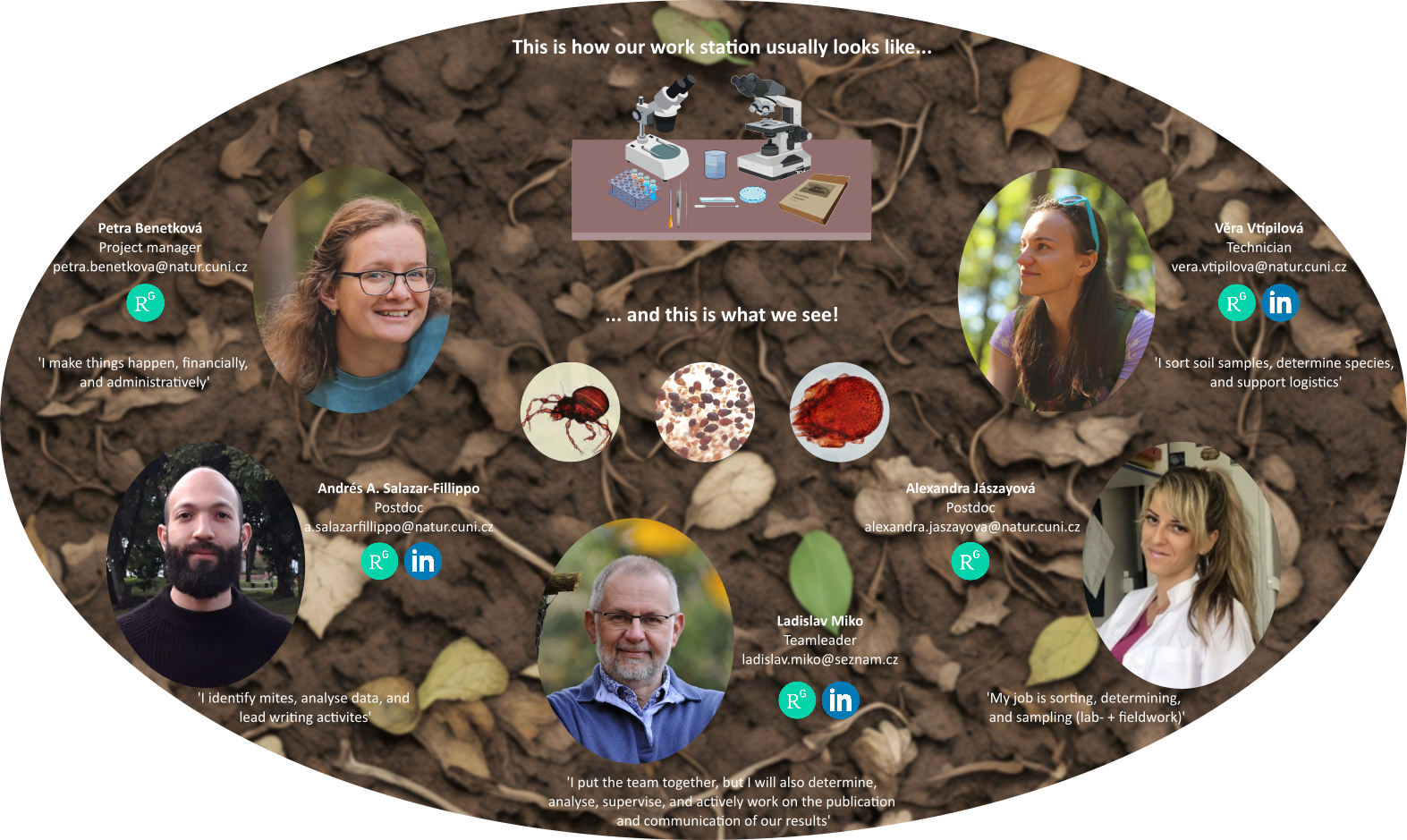Research is focused on the study of relationships between organisms, their environment and processes that influence the functioning of ecosystems. Within ecosystem ecology, we examine energy flows, nutrient cycles, and interactions between biotic and abiotic components of nature. In soil ecology, on the other hand, the focus is on the composition, structure and function of the soil, its inhabitants (microorganisms, plants, animals) and their influence on soil processes, such as the decomposition of organic matter or carbon storage. Both disciplines are key to understanding the sustainability of ecosystems, the protection of biodiversity and the efficient management of natural resources.
Ecosystem ecology and ecosystem restoration
- The group conducts research dealing with the interaction of individual components of ecosystems and their changes during primary succession, these findings are subsequently applied to the development of restoration methods for severely disturbed ecosystems.
- Intensive research is carried out in the area of geochemical cycles and their interactions with ecosystem processes and thus forms an integral part with the design of ecosystem ecology. The main content is the study of individual biogeochemical cycles and their interactions, as the main driver of changes in the development of ecosystems, and at the same time monitoring the influence of structural changes in ecosystems caused by other factors (e.g. the influence of the climate gradient on the biogeochemical cycles of given ecosystems). Special attention is paid to the biogeochemical cycles of biogenic elements (carbon, nitrogen, phosphorus) in relation to other key elements and natural conditions.
- In terms of the structural development of ecosystems, the research focuses on the interactions of the underground and above-ground parts of the ecosystem, the interactions of plants, soil organisms and the abiotic environment of soils and their importance in the dynamics of ecosystem development and the renewal of biogeochemical cycles.
- The main model ecosystems are dynamically developing ecosystems after large-scale disturbances such as mineral extraction, agricultural activity or restoration of oligotrophic ecosystems using the topsoil removal method. These types of ecosystems enable the monitoring of temporal changes both directly and with the help of chronosequences, i.e. groups of similar areas of different ages. Currently, we are intensively engaged in both the long-term monitoring of several chronosequences, especially on dumps after coal mining, and the comparison of the development of ecosystems after similar disturbances along climatic gradients.
- Team:
prof. Mgr. Ing. Jan Frouz, CSc.
RNDr. Mgr. Ondřej Mudrák, Ph.D.
SoilScope - Soil Biodiversity Group
-
We are a contributing group for the SOB4ES project, which operates on a European scale. The project aims to develop an integrated framework that illustrates the impact of soil biodiversity on ecosystem services over time and across different regions. This framework will help assess ecosystem conditions, implement soil biodiversity-friendly management interventions, identify restoration and conservation targets, and translate scientific knowledge into effective policies and solutions.
-
Our team will play a crucial role in the SOB4ES project by collecting soil biodiversity data, analysing patterns under land use changes, and providing land management and policy advice.
- Team:
doc. RNDr. Ladislav Miko, Ph.D.
Mgr. Ing. Andrés A. Salazar-Fillippo, Ph.D.
RNDr. Alexandra Jászayová, Ph.D.
List of 2020-2025 Publications - SoilScope Members
Salazar-Fillippo, A. A., Emsens, W.-J., Strybos, S., Liczner, C., Miko, L., Frouz, J., Verbruggen, E., & van Diggelen, R. (2025). Effects of microarthropod density on soil fungal community composition in nutrient-poor ecosystems. Functional Ecology, 00: 1–14. https://doi.org/10.1111/1365-2435.14733
Miko, L., Kolesnikov, V. B., & Murvanidze, M. (2024). Taxonomy of European Damaeidae (Acari: Oribatida) XII. Trimetabelba Miko gen. nov. with redescription of T. propexa (Kulczynski, 1902) comb. nov. description of two new species and proposal of Prometabelba Miko gen. nov. International Journal of Acarology, 50(8), 668–686. https://doi.org/10.1080/01647954.2024.2394244
Salazar-Fillippo A. A., Tulande-M., E., Miko, L. (2024). Update of the national checklist and new records of oribatid mites (Acari: Sarcoptiformes) in conserved relicts within urban areas in Bogota D.C. (Colombia). Acarologia 64(3): 941-951. https://doi.org/10.24349/kprn-xkaq
Salazar-Fillippo, A.A., Gutiérrez-Cárdenas, P.D.A., López-Bedoya, P.A., (2024). Supernumerary presence of the oribatid mite Archegozetes sp . Grandjean , 1931 in stomach contents of the túngara frog Engystomops pustulosus ( Cope , 1864 ) encourages validation of interaction pathways : phoretic , parasitic , or prey ? International Journal of Acarology. https://doi.org/10.1080/01647954.2024.2312221
Wadoux, A. M. J.-C., Courteille, L., Arrouays, D., De Carvalho Gomes, L., Cortet, J., Creamer, R. E., Eberhardt, E., Greve, M. H., Grüneberg, E., Harhoff, R., Heuvelink, G. B. M., Krahl, I., Lagacherie, P., Miko, L., Mulder, V. L., Pásztor, L., Pieper, S., Richer-de-Forges, A. C., Sánchez-Rodríguez, A. R., … Wetterlind, J. (2024). On soil districts. Geoderma, 452, 117065. https://doi.org/10.1016/j.geoderma.2024.117065
Ermilov, S. G., Miko, L., Kolesnikov, V. B., & Salavatulin, V. M. (2023). Ontogenetic instars of the oribatid mite Spatiodamaeus kalugaensis sp. Nov. (Acari, Oribatida, Damaeidae) from Russia. Zootaxa, 5324(1), 49–65. https://doi.org/10.11646/zootaxa.5324.1.7
Jászayová, A., Režnarová, J., Chovancová, G., Kostygov, A., Yurchenko, V., Antolová, D., Zwijacz-Kozica, T., Csanády, A., Hurníková, Z. (2023). Study of Oribatid Mites as Potential Intermediate Hosts of Anoplocephalid Tapeworms of Tatra chamois and Tatra marmots from the Tatra Mountains, Central Europe, and Report of a New Intermediate Host for Andrya cuniculi, the Parasite of Leporidae. Life, 13: 955. https://doi.org/10.3390/life13040955
Salazar-Fillippo, A. A., Srinivasan, J., van der Bij, A. U., Miko, L., Frouz, J., Berg, M. P., & van Diggelen, R. (2023). Ecomorphological groups in oribatid mite communities shift with time after topsoil removal – Insight from multi-trait approaches during succession in restored heathlands. Applied Soil Ecology, 191 (June), 105046. https://doi.org/10.1016/j.apsoil.2023.105046
Benetková, P., van Diggelen, R., Háněl, L., Vicentini, F., Moradi, R., Weijters, M., Bobbink, R., Harris, J. A., & Frouz, J. (2022). Soil fauna development during heathland restoration from arable land: Role of soil modification and material transplant. Ecological Engineering, 176. https://doi.org/10.1016/j.ecoleng.2021.106531
Benetková, P., Háněl, L., & Frouz, J. (2022). Nematode Assemblages Development Twenty-One Years after the Introduction of Meadow Soil into Bare Post Mining Spoil Heap. Diversity, 14(567). https://doi.org/https://doi.org/10.3390/d14070567
Jászayová, A., Ľuptáčik, P., Csanády, A., Hurníková, Z., Chovancová, G. (2022). Biodiversity of oribatid mites (Acari: Oribatida) in the Tatra Mountains, with notes on the intermediate hosts of tapeworms. International Journal of Acarology, 48(8): 605-618. https://doi.org/10.1080/01647954.2022.2161630
Kolesnikov, V. B., Miko, L., Marchenko, I. I., & Azimi, N. (2022). The oribatid mite subgenus Metabelba ( Pateribelba ) (Acari, Oribatida, Damaeidae): Redescription of M. (P.) filippovi and description of two new species. International Journal of Acarology, 48(7), 535–550. https://doi.org/10.1080/01647954.2022.2134922
Miko, L., Kolesnikov, V. B., Ermilov, S. G., & Klimov, P. B. (2022). Taxonomy of European Damaeidae (Acari, Oribatida) XI. European species of the genus Piribelba Miko 2021: Redescriptions of P. rossica (Bulanova-Zachvatkina, 1957) and P. piriformis (Mihelčič, 1964) using morphology and DNA sequence data, Zootaxa (Vol. 5187, Issue 1).
Moldovan, O. T., Miko, L., Panaiotu, C., Roban, R.-D., Gąsiorowski, M., Hercman, H., Orza, R., Kenesz, M., Mirea, I. C., Petculescu, A., Robu, M., & Constantin, S. (2022). Small Human Population Drastic Impact, as Inferred From Multi-Proxies of a Temporary Carpathian Lake. Frontiers in Earth Science, 10, 856685. https://doi.org/10.3389/feart.2022.856685
Norton, R. A., Ermilov, S. G., & Miko, L. (2022). Kunstidamaeus arthurjacoti sp. Nov. (Oribatida, Damaeidae), first report of the genus in North America. Systematic and Applied Acarology. https://doi.org/10.11158/saa.27.3.7
Salazar-Fillippo, A.A., Teunkens, B., Leirs, H., Frouz, J., van Diggelen, R., Miko, L., (2022). Quantitative assessment of the dispersal of soil-dwelling oribatid mites via rodents in restored heathlands. Ecology and Evolution. 12, 1–14. https://doi.org/10.1002/ece3.9653
Salazar-Fillippo, A.A., Miko, L., (2022). Checklist of the oribatid mites (Acari: Oribatida) of the Republic of Colombia. Zootaxa 5087: 35–58. https://doi.org/10.11646/zootaxa.5087.1.2
Benetková, P., Tichý, L., Háněl, L., Kukla, J., Vicentini, F., & Frouz, J. (2020). The effect of soil and plant material transplants on vegetation and soil biota during forest restoration in a limestone quarry: A case study. Ecological Engineering, 158(August), 106039. https://doi.org/10.1016/j.ecoleng.2020.106039
Cameron, A., Boilard, G., Dubois, R., Bradley, R., Benetková, P., Józefowska, A., Thevathasan, N., Whalen, J., & Šimek, M. (2021). Distribution of earthworm communities in agroecosystems with forested riparian buffer strips: A multiscale study. Applied Soil Ecology, 167(July 2020), 104035. https://doi.org/10.1016/j.apsoil.2021.104035






















